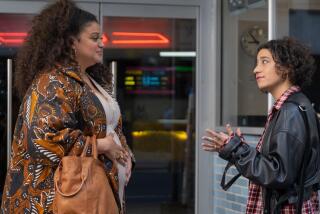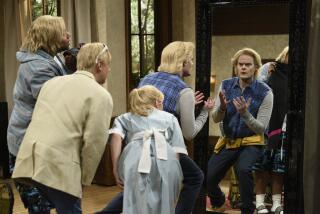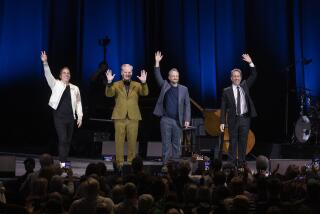All for Laughs : Spotlight to Be on ‘Funniest Home Videos’ Crew at Rancho Santiago Benefit
- Share via
SAN DIEGO — It’s your typical children’s birthday party scene: Dad’s video camera is rolling while a curly-topped tyke is poised to blow out the candles on her cake.
“Theresa, how old are you?” he coaxes. They don’t know it, but as she slips out of sight and the cake comes tumbling after her, the surprised but undamaged toddler has just cinched her debut on national television.
Spontaneous, embarrassing and often hilarious moments from daily life are the stuff of that has made “America’s Funniest Home Videos” one of the biggest TV hits of recent years.
When it made its debut on ABC in 1990, the program rocketed to the top of the Nielsen ratings, much to the surprise of almost everyone, including its creator and executive producer, Vin Di Bona.
“No one can figure what happened to us,” Di Bona said. “Once the pilot aired, an order came to do the series six weeks later, and we had no tapes in house.”
But that changed quickly. And the show, now in its third season, has since amassed a library of 180,000 usable tapes. DiBona, who has won Emmy and Peabody awards for his documentaries, is bringing his production crew tonight to Orange County, where, for a change, the members will be in front of the cameras as the featured guests for the Rancho Santiago College 10th annual “Tribute to a TV Classic.”
The event is a fund-raiser for the college telecommunications department and is open to the public. Proceeds will benefit its scholarship and production fund. The event will include a screening of highlights from the show’s first two seasons, a discussion of behind-the-scenes goings-on, and an appearance--on video--by host Bob Saget.
The show still receives between 350 and 500 tapes every day, DiBona says. That’s down from the 2,000-a-day deluge typical of last year, when the show was becoming a sensation.
“The Hollywood post office had to put on three additional staffers to handle our mail,” Di Bona said of that time. “It’s much more manageable at this point. . . . People understand the show, and they know what we’re looking for.”
A large part of what’s no longer coming in is tapes of staged incidents and phony accidents in which participants appear to get hurt--sent by viewers eager to get air time (and big bucks) for their creations.
On their end, Di Bona said, screeners quickly became better at spotting fakes, so that such tapes could be rejected outright. He also instituted a policy of background checks to inquire about injuries. “If someone falls down and there was a serious injury, we will not air the video,” he said.
Di Bona says now that viewers have caught on, the number of staged submissions has dropped off. But the initial scare prompted Saget to add a tagline weekly that urges viewers to “Keep those cameras safely rolling.”
To glean the 45 to 50 clips needed for a single show, the show’s team of five screeners may watch as many as 400 tapes. These may come from anywhere in the world, a reflection of the show’s growing international appeal. In fact, “America’s Funniest,” which now airs in 49 countries, owes its beginnings to a program that originated in Japan.
What subjects do tickle audiences’ funny bones? Preening pets, falling-down pants, spills from ponies, toddler tumbles and klutzy brides all seem to be favorites. Last week, for instance, viewers watched a couple walk down the church steps, although the train on the bride’s headpiece stayed behind--stuck on the door.
Although “Funniest” is no longer the top-ranked show, it still remains in the Top 20, and it regularly introduces new features in order to maintain audience interest--and to keep those videotapes coming.
For one element of the show, producers are making the rounds of college and high school campuses in search of student creations, many of which are comic take-offs on movies.
“There’s a lot of creative talent out there, and we want to tap into that,” Di Bona said.
But the executive producer says his team is always on the lookout for the show’s staple--the hilarious spontaneous moment. The lure is not just the $10,000 weekly prize for the funniest submission (and a chance to be on the program to introduce the reel), but also the season-ending grand prize of $100,000.
“Surprisingly,” Di Bona said, many people “don’t think their tapes are funny enough.” Last season’s winner--a youngster screaming his ABCs--was ultimately sent in by the child’s insistent grandmother.
“TV Tribute” organizer Terry Bales, chairman of the college communications department, says this year’s event brings his annual benefit effort full circle. In 1981, the classic honored was Allen Funt’s “Candid Camera.”
The difference between Funt’s original “reality show” and its offspring, Bales said, is that “now the audience is not only the people being semi-embarrassed, but they’re also the ones behind the camera. The camcorder shooters--they’re the ones who are the stars right now too.”
According to Bales, who teaches courses in the history of television and mass media, “reality TV is in now, and this is one of the forms, along with police-reality forms and news-reality. This is the fun-reality of the three.
“A show like this captures the essence of the new technology,” he added. “So many people are entertaining themselves with their own home cameras. It was inevitable this kind of show would come about . . , and it was the first to really capture the camcorder craze that’s out there.”
Tonight, his students will be joining the audience to watch the amateur video efforts of others and to listen to Di Bona describe how the video revolution is changing television.
What’s behind the popularity of “Home Videos?”
“There’s an element of heart to the show,” says Saget. “And I think people like it; they like to see real people.”
“It is grass-roots,” DiBona said. “It’s popular with children because they can see that adults can make the same mistakes they do, and popular with adults because they can see their neighbors make the same mistake they do. In a great sense, it’s little mini-documentaries that people are sending in of American life. They are documenting their lives.”
The 10th Annual “Tribute to a TV Classic” begins tonight at 7 at Phillips Hall Theatre on the Rancho Santiago College campus, Santa Ana. Doors open at 6 p.m. Tickets: $10 at the door. Information: (714) 564-5600.
More to Read
The complete guide to home viewing
Get Screen Gab for everything about the TV shows and streaming movies everyone’s talking about.
You may occasionally receive promotional content from the Los Angeles Times.






